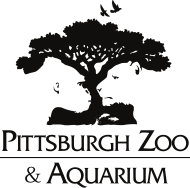Highland Park Zoo
 |
|
| Date opened | June 14, 1898 |
|---|---|
| Location | Pittsburgh, Pennsylvania, United States (in Highland Park) |
| Coordinates | 40°29′02″N 79°55′05″W / 40.484°N 79.918°WCoordinates: 40°29′02″N 79°55′05″W / 40.484°N 79.918°W |
| Land area | 77 acres (31 ha) |
| No. of animals | Over 4,000 |
| No. of species | 475 |
| Major exhibits | Forest Passage, African Savanna, Tropical Forest, The Islands, Jungle Odyssey, PPG Aquarium, Water's Edge, Kid's Kingdom |
| Website | www |
The Pittsburgh Zoo is one of only six major zoo and aquarium combinations in the United States. Located in Pittsburgh, Pennsylvania's Highland Park, the zoo sits on 77 acres (31 ha) of park land where it exhibits more than 4,000 animals representing 475 species, including 20 threatened or endangered species.
The zoo's accredited membership of the Association of Zoos and Aquariums (AZA) was dropped in 2015.
The Pittsburgh Zoo opened on June 14, 1898, as Highland Park Zoo, after Christopher Lyman Magee donated $125,000 (about four million dollars when adjusted for inflation) for the construction of a zoological garden in Pittsburgh's Highland Park. Like most other zoos of the time, the Pittsburgh Zoo more closely resembled a menagerie than an actual zoo. However, as time progressed, the animal exhibits eventually became more naturalistic, and the zoo's goal became more focused on conservation.
In 1937, the bear exhibits were built under the Works Progress Administration. These exhibits were the zoo's first attempt at constructing more naturalistic exhibits instead of simply displaying animals in cages. In 1949, the Children's Zoo opened with a grant from the Sarah Mellon Scaife Foundation. The Children's Zoo contained interactive exhibits and play areas for children, including a simulated large chunk of cheese that was inhabited by dozens of live mice. In 1967, the AquaZoo, a large aquarium, opened to the public. At the time of its completion, the AquaZoo was the only aquarium in Pennsylvania and the second largest aquarium in the United States.
In 1980, the zoo's Master Plan was put into effect. This plan called for extensive renovations and the construction of more naturalistic exhibits. The Asian Forest, which opened in 1983, was the first area of the zoo that utilized this new philosophy of naturalistic exhibits. The African Savanna was the next area to obtain naturalistic exhibits when it was completed in 1987. 1991 marked the opening of the Tropical Forest, a five-acre indoor rainforest showcasing about 16 species of primate and 150 tropical plant species. That same year, the Children's Zoo was renovated and renamed the Children's Farm. Three petting zoos were built in Children's Farm where children could pet kangaroos, deer, and domesticated animals such as sheep and goats.
...
Wikipedia
